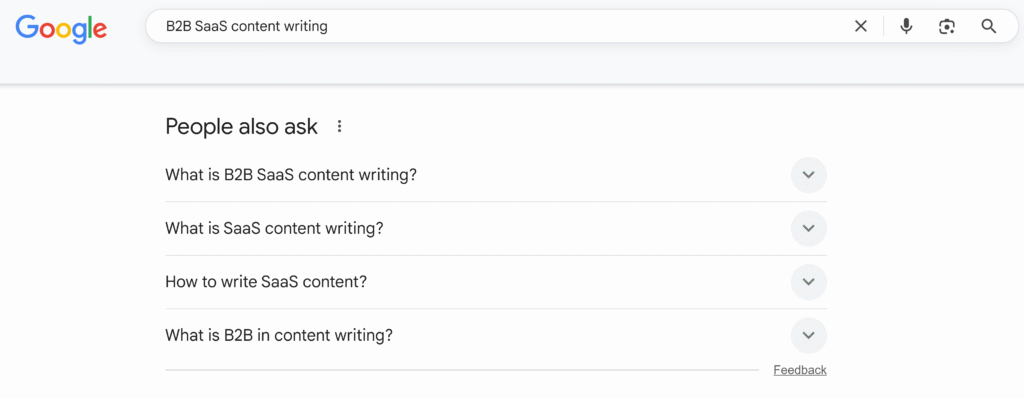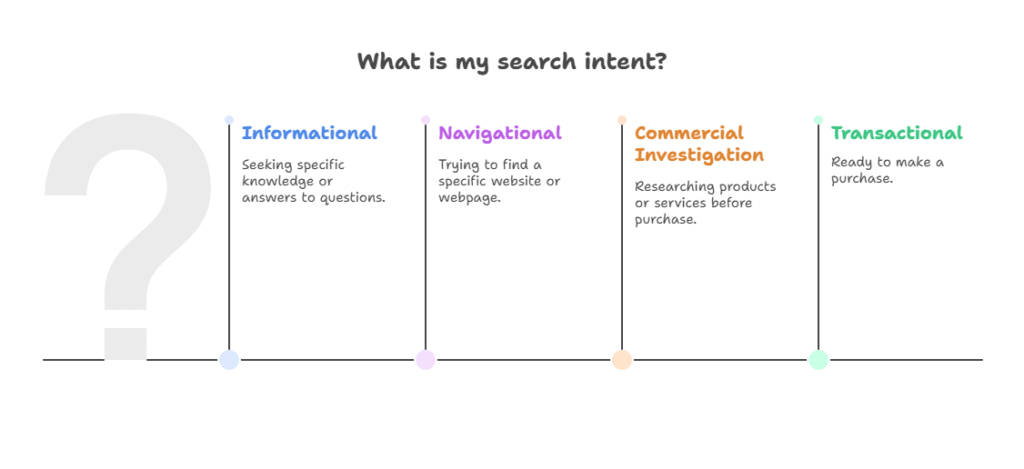Why do some blogs dominate Google’s first page while others never make it past page two? The answer lies in SEO content writing – a mix of strategy, creativity, and user-focused value.
Forget keyword stuffing.
In this guide, you’ll learn how to master keyword research, build reader-friendly structures, and apply writing tactics that make Google (and your audience) take notice.
Research and prepare keywords for SEO content
Find keyword gaps your competitors missed
Did you know that over 90% of web pages get no organic traffic from Google? A major reason is failing to target the right keywords. Keyword gap analysis helps identify valuable keywords your competitors rank for that you don’t.
“Keyword research is critical to SEO as it helps align your website with your customer’s search intents.”
– Neil Patel
This process involves comparing your website’s keywords with competitors to discover high-value opportunities you’ve missed. It reveals underperforming keywords that might be sitting on page 2 of Google, helping you prioritize content creation for better ROI.
By focusing on these gaps, you’ll develop content that aligns with what your audience is actually searching for, rather than guessing what might work. This strategy enhances your content plan, boosts search visibility, and provides crucial market insights.
Use long-tail and semantic keywords smartly
Long-tail keywords, those longer, more specific phrases, might have lower search volume individually, but they often convert better because they capture users with specific intent. Instead of targeting just “content writing,” targeting “B2B SaaS content writing services” attracts visitors who know exactly what they want.

Google’s ‘People Also Ask’ reveals semantic keyword opportunities you can naturally integrate.
Modern search engines understand context and relationships between words. Semantic keywords, related terms that help search engines understand your topic more thoroughly, are crucial for comprehensive coverage. For example, an article about coffee brewing should naturally include terms like “grinding beans,” “water temperature,” and “extraction time.”
Find semantic keywords by checking Google’s “People also ask” section, “Related searches,” or using specialized tools that analyze top-ranking content.
Map keywords to search intent accurately
Understanding search intent, the “why” behind a search query, is crucial for effective SEO content. The four main types are:
- Informational: Users seeking information (guides, definitions)
- Navigational: Users looking for a specific website
- Commercial investigation: Users researching before purchasing
- Transactional: Users ready to buy

4 Types of Search Intent Explained
To map keywords to intent, analyze what’s currently ranking for your target term. If Google shows product comparison pages for “best coffee makers,” users likely want comparative information, not a basic explanation of how coffee makers work. Aligning your content with the correct search intent dramatically increases your chances of ranking well.
Structure your SEO content for clarity and flow
Follow a proven SEO content writing format
Successful SEO content follows a structure that guides readers logically while satisfying search engines:
- Compelling introduction that hooks readers and incorporates your primary keyword
- Clear thesis statement that outlines what readers will learn
- Logically organized sections with descriptive headers
- Transition sentences that guide readers between sections
- Conclusive summary with next steps or a call to action
This structure creates a better reading experience, reducing bounce rates and sending positive signals to Google about your content quality. Plus, a consistent format speeds up your content creation process.
Write scan-friendly headers and short paragraphs
In 2025, writing SEO-friendly content means optimizing for both search engines and user experience. Most online readers scan content rather than reading every word, so make your content scan-friendly by:
- Using descriptive headers that preview each section
- Keeping paragraphs short (2-3 sentences max)
- Incorporating bulleted and numbered lists
- Using bold text for key points
- Including relevant images with descriptive alt text
According to SEMrush, SEO writing helps build brand authority when it prioritizes both reader experience and search optimization. Breaking content into digestible chunks allows readers to get value even when just scanning.
Use compelling title tags and meta descriptions
While not visible in your main content, title tags and meta descriptions are crucial SEO elements that impact click-through rates from search results.
For title tags:
- Keep them under 60 characters
- Include your primary keyword near the beginning
- Use power words that trigger emotion
For meta descriptions:
- Stay within 155-160 characters
- Include your primary keyword naturally
- Write a compelling summary with a clear call to action
Both elements should accurately represent your content. Misleading titles or descriptions lead to high bounce rates that hurt rankings.
Follow writing best practices that Google rewards
Write naturally while placing keywords strategically
SEO content writing has evolved dramatically. In the past, writers followed rigid formulas with exact keyword placement throughout articles. Today, Google understands context and semantics, making keyword stuffing not just ineffective but potentially harmful.
Instead, focus on:
- Using your primary keyword in the title, first paragraph, and at least one H2
- Incorporating semantic keywords naturally throughout
- Prioritizing readability over keyword density
- Writing for humans first, search engines second
Remember that SEO is about helping search engines understand your content while helping users find your site. When you write naturally while strategically placing keywords, you create content that serves both purposes effectively.
Balance user clarity and SEO with internal linking
Internal links serve dual purposes. They provide additional information for users while establishing site structure for search engines. To optimize internal linking:
- Link to relevant content on your site
- Use descriptive anchor text that includes keywords when natural
- Prioritize linking to cornerstone content
- Ensure links add genuine value
Avoid generic anchor text like “click here.” Instead, use descriptive phrases that tell both users and search engines what to expect when clicking the link.
Structure content for readability in 2025
Modern readability practices include:
- Ensuring content loads quickly on all devices
- Designing with a mobile-first mindset
- Using descriptive subheadings
- Incorporating multimedia elements
- Including interactive elements when relevant
- Optimizing for voice search with conversational phrasing
Also consider accessibility. Use alt text for images, maintain good color contrast, and structure content with proper heading hierarchy to expand your potential audience.
Maintain freshness and update outdated SEO pages
Google values fresh, updated content. Regularly updating your existing content:
- Signals to Google that your site is active
- Provides users with accurate information
- Creates opportunities to target new keywords
- Improves content based on performance data
Implement a content audit schedule to identify pages that need updating. After making changes, request reindexing through Google Search Console to ensure Google recognizes your updates quickly.
Conclusion
Creating content that ranks isn’t about tricks. It’s about understanding your audience and search engines, then crafting content that serves both masterfully. By researching keywords strategically, structuring content thoughtfully, and following Google’s best practices, you’ll create SEO content that not only ranks but delivers real value to readers.
Remember that SEO content writing is both art and science. While technical aspects matter, never lose sight of the humans seeking answers, insights, or solutions. When you balance technical optimization with genuine value, you create content that stands the test of time, even as algorithms continue to evolve.
FAQs
What is SEO content writing and how does it work?
SEO content writing is creating valuable content optimized to rank in search engines while engaging readers. It works by incorporating relevant keywords your audience searches for, structuring content for easy reading, and following technical best practices. Effective SEO content satisfies both search algorithms and user intent, driving organic traffic to your website.
How does a seo content writer use keywords effectively?
An SEO content writer uses keywords effectively by researching relevant terms with good search volume and reasonable competition, then incorporating them naturally into strategic locations (title, headers, opening paragraph). Modern SEO focuses on semantic keywords and comprehensive topic coverage rather than keyword density, ensuring content thoroughly addresses the subject while maintaining readability.
What are common mistakes in content writing for SEO?
Common mistakes include keyword stuffing, creating thin content, ignoring search intent, neglecting mobile optimization, using overly complex language, failing to update old content, and missing technical elements like meta tags. Another frequent error is prioritizing search engines over human readers, leading to awkward phrasing and poor user experience.
How long should SEO content be to rank on Google?
There’s no universal ideal length. It depends entirely on the topic and search intent. Comprehensive guides often perform well at 1,500+ words, while straightforward topics might need only 800-1,000 words. Focus on covering the topic thoroughly rather than hitting an arbitrary word count. Quality and comprehensiveness matter more than length.
What tools can help with SEO content writing?
Helpful tools include keyword research platforms like SEMrush and Ahrefs (premium at $100+ monthly) or Ubersuggest ($29-49 monthly), content optimization tools like Clearscope or Surfer SEO, and readability checkers like Grammarly and Hemingway Editor. Google Search Console provides performance insights, but remember, quality writing addressing real human needs remains fundamental.
How do you optimize existing content for better SEO?
Start with a content audit to identify underperforming pages. Update outdated information, add relevant new sections, and incorporate additional keywords. Improve readability with better formatting and descriptive subheadings. Enhance internal linking, fix broken links, and update external references. Refresh meta tags and ensure mobile responsiveness, then request reindexing through Google Search Console.



